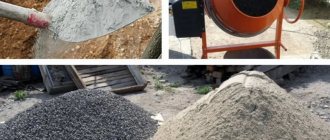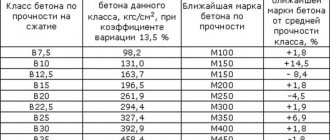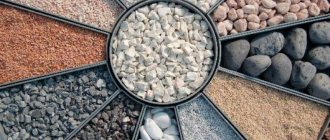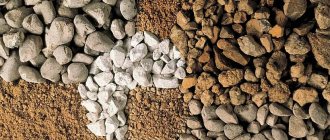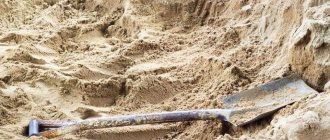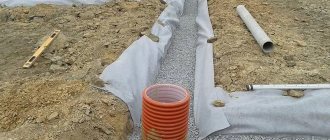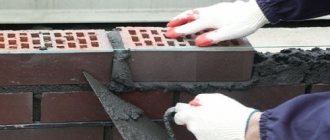Cement is an amazing substance that allows you to produce various mixtures and solutions for all types of construction, finishing and repair work.
Cement is a powdery, water-hardening binder. This means that only in the presence of water do the hydration reactions necessary to chemically transform the powder component into a solid material with a crystalline structure occur. Therefore, to work with cement, solutions and mixtures are mixed from it with the addition of water.
The main types of such materials are concrete mixtures and cement mortars.
What is the difference between cement mortar and concrete mixture?
The main difference between these types of building materials is their composition, which determines the difference in their qualities and different areas of their application. They also have common features: the use of cement as a binder makes it possible to obtain materials that are particularly durable.
In fact, concrete can be called a composite material. If for the production of a concrete mixture, in addition to cement, water and sand, a coarse aggregate is also required, for example, gravel or crushed stone with different fraction sizes, then only fine aggregate - sand - is added to the cement mortar.
Thus, the composition of the cement mortar includes:
- cement;
- sand;
- water.
The scope of application also differs. Concrete is used for the manufacture of large products and structures, for example, monolithic walls and floor slabs, road surfaces, screeds, as well as small-piece products that require high strength, for example, paving slabs.
Cement mortars are used as a material for filling joints and joining building elements (masonry mortars) or for surface treatment (for example, various types of plaster mortars using cement).
Important!
Cement and mixtures based on it have been used in construction since the times of Ancient Rome, but modern building materials differ significantly from ancient samples due to advances in chemistry. Any types of concrete mixtures and cement mortars require the use of special chemical additives that can provide them with additional properties:
- plasticity of the mixture and increase in its lifespan;
- ability to work at sub-zero temperatures;
- increased strength and crack resistance;
- frost resistance of the finished product;
- fast setting;
- water resistance
and other characteristics that may be necessary in a particular case. Thanks to the use of chemical additives, truly impeccable cement products can be obtained.
We advise you to study: Cemmix Additives Catalog
Step-by-step process for preparing mortar
There are many ways to prepare solutions. We will describe the highest quality, fastest and optimal of them.
- Water . If you are preparing not a dry mixture, but a classic ordinary solution in a concrete mixer, first of all you need to pour water into it. However, its exact amount cannot be determined in advance and one should not rely on any formulas. So, for example, the amount of water will decrease if wet sand is used. The simplest way to make a preliminary calculation is to focus on the amount of cement. For example, if a batch requires one bucket of cement, approximately the same amount of water will be required - about one bucket. In order not to get an excessively liquid solution, it is better not to overdo it with the amount of water and fill it a little less than the required amount. At the same time, if there is too little liquid, you will have to constantly add water, then add cement or sand. This will lead to a significant lengthening of the process of preparing the solution. If the types are poured quite a bit less than the norm, mixing sand with cement in a liquid state will happen much faster than in the case of a thick solution. When the last components of cement and sand are added to the concrete mixer, the remaining water is added by eye. In order for sand and cement to be mixed better and faster, they must be in a liquid state. And the required density of the solution is adjusted at the end of the batch. When more water is added than required and the solution turns out to be too liquid, nothing bad will happen. You just need to add a little cement and sand in the same proportions required for this brand (1:4, 1:3, etc.).
- Detergent . Not a very common additive, which, nevertheless, is very useful and significantly improves the quality of the resulting solution and makes it elastic. It is best to add liquid soap or dishwashing detergent. Quality (let alone brand awareness) is not particularly important, the main thing is that the product foams. If the amount of the required solution is not too small, it is best to buy them in large five-liter plastic bottles, they are cheaper than small ones. While preparing the solution, approximately 50-100 grams of detergent are added to the mixer. Its exact quantity cannot be determined, since it depends on various factors. This component is added after the water is poured in, then good dissolution and foaming will occur. For final dissolution and foaming in a running concrete mixer, three to five minutes are enough. If you add detergent at the end of the kneading, the dissolution will be poor and the elasticity will hardly improve.
- Sand . Sand should be added next to the detergent (after it is well dissolved). However, it is not poured all at once, but half of the total amount required for the entire batch. So, if a mortar of grade 100 is prepared using cement 400, two of the required four parts are poured into the first fill.
- Cement . After half of the added sand, cement is poured into the concrete mixer - the entire amount required for mixing. After this, you need to wait a couple of minutes for it to be completely mixed with water and sand.
- Sand . When all the cement in the concrete mixer is completely mixed with other ingredients, the remaining sand is added to the resulting mass. If necessary, the missing part of the water is added and at the end of the process the density of the solution is adjusted. After this, the solution is finally mixed for three to five minutes.
As a result, the resulting solution should be neither too thick nor too thin. Its consistency should be similar to store-bought sour cream. The shape of the solution should hold fairly well. To check, you can try to write or draw something on its surface. The written letters should not blur.
Summary: preparing a good double-mix mortar in a concrete mixer (approximately eight buckets of ready-made sand-cement mixture) requires only about fifteen minutes.
Types of cement mortars
The popularity of cement mortars in construction, finishing and repair work is explained by their strength and availability.
We can talk about the classification of cement mortars according to their composition and purpose.
Based on their composition, cement mortars are divided into the following types:
- Cement-sand. The solution is mixed with the addition of sand, which is a component that forms a crystalline structure and prevents shrinkage and cracking. Sand of medium fractions is used. Cement mortars are used for masonry and plastering of walls. Cement plaster is durable, vapor-permeable and resistant to fungus and mold. It can be used under any type of coating, including decorative tiles, and can also be used for finishing the external walls of buildings.
- Cement-lime. Cement-lime plaster combines two binder components, of which cement is a water-hardening binder, and lime is an air-hardening binder. Slaked lime reduces the cost of the solution and also works as a plasticizer, increasing its mobility. Cement-lime plaster can be used for finishing any premises, including wet ones, as well as building facades. Its advantages are plasticity, strength, layer-by-layer application capabilities, moisture resistance, resistance to mold, mildew, availability and cost-effectiveness.
Types of cement mortars by purpose:
- masonry;
- plastering;
- repair;
- solutions for screeds.
Depending on the purpose of the solution, the brand of cement, the composition of the solution and the proportions of the main components are selected. Plastering mortars must be more plastic than masonry mortars, which is achieved by using various additives: slaked lime or special plasticizers.
Interesting!
Regular cement is gray in color, but white is available for finishing work. It is used for mixing plaster solutions, as well as mixtures for making colored paving slabs, since gray cement does not allow obtaining bright, beautiful shades. White cement is more expensive than regular cement, so it is often used for mortar that is applied to the surface (the top layer of plaster or paving stones).
What is the difference between cement and concrete mortars
There are still people who confuse concrete and cement, but these materials still have a number of features. To see the difference between cement mortar and concrete mixture, refer to the table:
| Comparison criterion | Cement | Concrete |
| Compound | Cement, sand, water | Cement, water + fillers (crushed stone, gravel, pebbles, etc.) |
| Purpose |
|
|
| The need for sifting | Yes | No |
| Adhesion | Average | High |
| Ease of installation | Homogeneous consistency contributes to more even placement of the solution | Frequent formation of voids is caused by the heterogeneous composition and low density of the mixture. |
Which brand of cement to choose
As is known, cement is classified according to strength into grades, which were previously designated by the letter M and a numerical indicator characterizing the compressive strength in kg/cm2. The higher the indicator, the more durable products can be obtained from this cement.
Important!
Today, the marking of cementitious powder begins with the type of cement CEM, after which the percentage and type of additives are indicated. Next, the strength class and setting speed are noted. For example, CEM II/V-Sh 22.5N is Portland cement with granulated blast furnace slag 21-35%, strength class 22.5, with a normal hardening rate.
However, many consumers still use the old classification, so some manufacturers put both markings (according to the old and new classification) on bags of cement.
When carrying out work, it is important to choose cement that is optimal in strength in order, on the one hand, to obtain sufficient strength of the products, and on the other hand, not to overpay for more expensive consumables.
This is why the correct choice of the optimal cement brand is so important:
- for plastering facades - CEM II 32.5N–CEM II 42.5N (M400–M500);
- for plastering interior walls for wallpaper or painting - CEM II 22.5N–CEM II 32.5N (M300–M400);
- for masonry mortars, cement grade CEM II 22.5N–CEM II 42.5N (M300–M500) is required, and the mortars are marked by strength from M25 (for unloaded masonry) to M200 (for highly loaded structures, such as foundations on soft soils ), the choice of a specific brand depends on the brand of brick; in the usual case, a mortar of the M50 or M75 brand is selected;
- for screeds, solutions from M200 (screed in an apartment), M300 (screed in an office), and higher for screeds that will be subject to high loads (for example, in industrial premises) are used.
Ingredients and equipment
To properly mix a cement solution, you need to decide on the main and additional components, as well as prepare the necessary equipment. As a rule, the choice of mixing method - manually or with a concrete mixer - is based on the required amount of solution.
So, to mix cement you will need:
- A container made of metal or durable plastic (cast iron bath, trough or stable basin) - for manual kneading. For large volumes of cement mixture, a concrete mixer is used;
- Shovel;
- Putty knife;
- Construction mixer (drill with attachments).
Since the solution is liquid for a short time, it is better to prepare suitable equipment in advance. Otherwise, you may waste time or waste materials.
The selection of ingredients must be taken seriously: their quality and mixing order play a major role in achieving the desired consistency and strength of the material. To dilute the “classic” cement mortar you will need:
- sand. Its uniformity and size determine the quality of the finished mixture. Do not use aggregate with high humidity: this will disrupt the technology, increasing the total amount of water.
- cement. The type and brand affect the strength of the mixture; they are chosen depending on the job. Here you need to know about the selection rules or follow the instructions.
- additional ingredients to improve the plasticity of the solution (plasticizers, liquid glass, etc.).
- water. It is better to make a solution using clean water, without dirt and impurities. Then the risk of violating the proportions and getting a bad result will be minimized.
Concrete calculation calculator for strip foundation
How to prepare cement mortar
It is quite possible to make a cement mortar yourself, and it will be cheaper than buying a ready-made one. In addition, in private construction and repair work, mixing yourself is more convenient.
Cement mortars are mixed in small concrete mixers or using a construction mixer, and if a little mortar is needed, then by hand.
It is usually recommended to first mix dry cement with sand, and then add water with chemical additives to the required thickness or, if slaked lime is used, its aqueous solution. Although some masters prefer a different kneading order.
The consistency of the solution is selected depending on the purpose and can be semi-dry, plastic, or even cast.
Any chemical additives are introduced into a solution with an aqueous component.
Video: How to properly mix cement mortar
Determining the required brand of solution
Theoretically, the brand of mortar used should match the brand of material used (blocks, bricks, etc.). So, for example, if brickwork is being built, and the brand of brick used is 100, then, ideally, the brand of mortar should match this number. The result is an almost homogeneous solid brick structure.
However, it is far from necessary to go too far and strive for absolute coincidence. If a facing brick corresponding to grade 350 is used in the construction of a house, the mortar does not have to be made according to the above formula.
Typically, for facing brickwork, a mortar with a grade corresponding to approximately 115 is used. To make it, two parts of cement to seven parts of sand (1/3.5) are laid in one batch. After about three weeks, after final drying, it is very difficult to hammer a nail into the seams of such a solution.
You should not think that an increase in the number of the brand of a solution necessarily leads to an increase in its quality. When mixing one to three, the solution will set too quickly and therefore it will not be very convenient to work with it. If the batch is done one to four, the seams of the facing brick will begin to crumble over time.
When constructing partitions from backfill bricks, the grade of which corresponds to 75, the solution used can also correspond to 75 (5.3 parts of sand are taken for one part of cement). And during construction from blocks (cinder blocks, shell rock, etc.), mortar grade 100 is usually suitable.
Proportions of components for cement mortars
What quantities of cement, sand and water to use depend on the purpose of the cement mortar.
Table 1. Proportions of plaster solutions
Table 2. Proportions of solutions for screeds
Table 3. Proportions of masonry mortars
Adding water
Water in cement mortar performs 2 main functions:
- Provides adhesion of ingredients. As a result of a chemical reaction, the solution hardens.
- Gives the mixture fluidity, which simplifies the process of laying and pouring the material.
The proportions of water are calculated individually: depending on the type of cement and fillers. Excessive amounts of water can adversely affect the quality of the mixture and cause air bubbles to appear after the liquid evaporates.
Additives for colored seams
Sometimes construction work must, in addition to the main one, also have an aesthetic, decorative result. This is where color additives come to the rescue. Their palette is extensive and they have the following features:
- the ability to improve appearance, avoid gray color;
- the ability to maintain a single style with a building, a house;
- does not affect the mixing technology, does not add difficulties to the work;
- it is possible to make a solution at home;
- resistance to external factors ensures the durability of the color coating.
If you need to make a solution of a bright color, then it is better to use white cement instead of gray.
How to make seams white
White color can emphasize the texture and volume of structures. Therefore, it is often used during masonry to give expressiveness to the building.
Perlite: what is it and insulation characteristics
To get a white color, add any of these ingredients to regular masonry mortar:
- slaked lime in larger quantities;
- apply nitric oxide;
- use titanium oxide.
You should choose based on financial capabilities, availability of materials and type of work.


